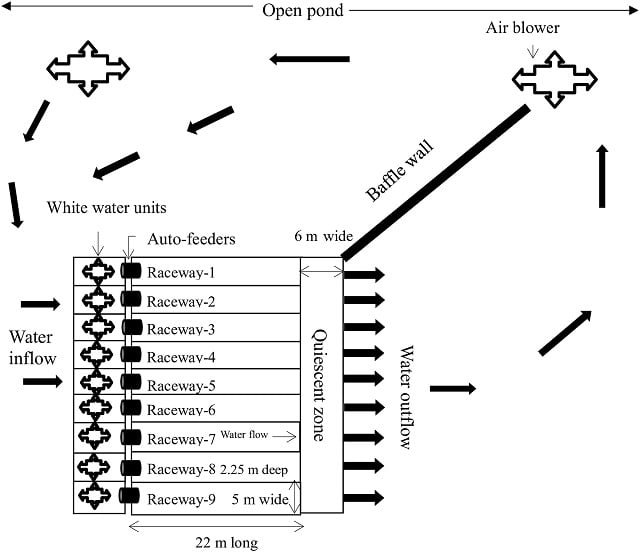
Maximizing production in fish farming is one of the primary goals for aquaculturists, as it is directly linked to the profitability of fish farms. However, intensifying cultivation can sometimes come at the cost of fish health.
A study led by scientists from Lahore College for Women University investigated the effects of stress caused by population density on tilapia (Oreochromis niloticus) cultured in the In-Pond Raceway System (IPRS).
IPRS: A Smart Water Aquaculture Solution
IPRS is an advanced technology that combines elements of recirculation systems, pond culture, raceway conduits, and cage culture. This innovative system prioritizes water conservation through careful treatment and recycling. While successful globally, the high cost and constant energy requirements may limit its adoption by small and medium-scale farmers in some regions.
Finding the Right Fish Density
The number of fish stocked in a pond (population density) significantly impacts farm productivity and profitability. However, overcrowding can have negative consequences, including:
- Reduced growth rate: Overcrowding conditions can hinder fish growth by affecting water quality, social behavior, and inducing stress-induced metabolic changes.
- Water pollution: High population densities can lead to increased waste accumulation, affecting water quality.
- Disease outbreaks: Overcrowding weakens fish immune systems, making them more susceptible to diseases.
Tilapia farming utilizes various population densities depending on the cultivation system. Previous studies have explored densities ranging from 0.28 kg/m3 to 15 kg/m3 in tanks, cages, hapas, and biofloc systems. However, the specific high density used in this study has not been previously investigated for tilapia in IPRS.
The Experiment: Balancing Numbers with Welfare
The study aimed to identify the optimal population density for tilapia in IPRS. Researchers evaluated the effects of different densities on growth, nutritional quality, stress levels, and antioxidant activity in fish. Ultimately, the goal was to establish optimal farming conditions for tilapia within IPRS, offering a practical solution for farmers seeking alternatives to traditional pond culture methods.
The research focused on the effects of Nile tilapia fry (young fish) overcrowding within an IPRS. Three population densities were tested: low (1.77 kg/m3), medium (2.32 kg/m3), and high (2.86 kg/m3). Each density level was replicated three times to ensure data accuracy.
Key Findings: Growth, Stress, and Adaptation
The study revealed interesting results:
- Growth: Fish in the high-density treatment (HSD) showed a decrease in daily weight gain compared to other groups.
- Survival: Fortunately, survival rates remained high (above 99%) across all densities.
- Stress response: The HSD group showed elevated cortisol levels, a well-known stress indicator in fish. This suggests increased crowding stress at this density.
- Nutritional value: Despite stress, fish meat quality was not significantly affected by population density.
- Antioxidant activity: Interestingly, the HSD group exhibited higher levels of antioxidant enzymes (superoxide dismutase, catalase, and glutathione peroxidase). These enzymes help combat the harmful effects of stress on cells.
- Digestive enzyme activity: In all densities, digestive enzyme activity (amylase, protease, and lipase) decreased throughout the experiment. This could indicate a shift in energy allocation, prioritizing stress management over digestion.
Conclusion: Achieving the Right Balance
This study investigated the effects of population density on tilapia raised in an In-Pond Raceway System (IPRS), a modern and intensive aquaculture system. Here are the main conclusions:
- Optimal density identified: A medium population density (MPD) of 2.32 kg/m3 was found to be ideal for tilapia growth and health within IPRS.
- High-density yields can still be achieved: Even at a higher density (HSD) of 2.86 kg/m3, the study achieved good final biomass and maintained high survival rates. However, some decrease in fish growth was observed at HSD.
- Overall fish quality remains intact: It’s important to note that, at all population densities, tilapia’s nutritional quality, immunity, and disease resistance were not affected.
- Promising approach for intensive aquaculture: These findings suggest that IPRS with high population densities may be a viable method for raising healthy tilapia while achieving desired yields.
- Industry-transforming potential: High-density tilapia aquaculture in IPRS has the potential to enhance production efficiency, economic viability, and resource utilization in the aquaculture industry, ultimately contributing to better food security.
Contact
Shafaq Fatima
Department of Zoology, Faculty of Natural Sciences, Lahore College for Women University
Lahore, Punjab, Pakistan
Email: shafaq.fatima@lcwu.edu.pk
Reference (open access)
Komal W, Fatima S, Minahal Q, Liaqat R. Investigating the optimum stocking density of tilapia (Oreochromis niloticus) for intensive production focused to in-pond raceway system. Science Progress. 2024;107(2). doi:10.1177/00368504241257128
Editor at the digital magazine AquaHoy. He holds a degree in Aquaculture Biology from the National University of Santa (UNS) and a Master’s degree in Science and Innovation Management from the Polytechnic University of Valencia, with postgraduate diplomas in Business Innovation and Innovation Management. He possesses extensive experience in the aquaculture and fisheries sector, having led the Fisheries Innovation Unit of the National Program for Innovation in Fisheries and Aquaculture (PNIPA). He has served as a senior consultant in technology watch, an innovation project formulator and advisor, and a lecturer at UNS. He is a member of the Peruvian College of Biologists and was recognized by the World Aquaculture Society (WAS) in 2016 for his contribution to aquaculture.
